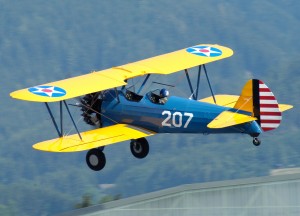Well, it’s that time of year again: as summertime recedes in the rear-view mirror, I’m packing my computer bag, a few snacks to eat on the (Air)bus, and heading back to school.
In case you’re wondering, yes, I did graduate from high school. And college, believe it or not — I’ve got the diploma to prove it! No, this late summer tradition is my annual trip to Dallas for recurrent training on the G-IV: five days of classroom learning and simulator sessions, ending with a formal checkride.
One of the questions typically asked by the instructor on our first day of class is if anyone has experienced anything in the previous year which was particularly noteworthy or unusual. A system failure, something of that nature. I’ve been pretty fortunate; the company I fly for does a bang-up job maintaining the fleet.
But while mentally reviewing the past year’s trips, my mind drifted off to the place where my heart truly belongs: light general aviation flying. Maybe it’s because the latest Joseph T. Nall Report was recently released by AOPA’s Air Safety Institute. Anyway, I don’t mind admitting a bit of wistfulness that GA can’t claim the same safety record that air carriers — even non-scheduled ones like mine that fly all over the world at a moment’s notice — enjoy.
Nevertheless, in an odd way I take comfort in the fact that the Part 91 safety record isn’t as good. That probably sounds awful, but look at it from a logical standpoint: Part 121/135 represent very specific kinds of highly structured and limited flying, whereas “GA†represents everything from airshow acts and experimental aviation to medevac and ultralights. It covers a wide and vibrant variety of aviation activity.

GA has a higher accident rate that the airlines for many reasons, but the primary one is that GA pilots have the freedom to do many things that the airline guys do not. And I hope that never changes. To paraphrase Dick Rutan, where would we be without those who were willing to risk life and limb using their freedom to do these things? We’d be safe and sound, on the ground, still headed west as we look out over the rump of oxen from our covered wagons.
Whether it’s cruising down the coast at 500′ enjoying the view, taking an aerobatic flight, flying formation, flight testing an experimental airplane, or landing on a sandbar, beach, grass strip, or back-country field, it’s important that private individuals not find themselves restricted to the ways and means of Part 121 operations. We do the stuff that make flying fun! Doing it “like the airlines†can only drive up the price and suck out the fun of aviation. For better or worse, part of that cost is in increased risk.
Richard Collins stated this quite elegantly when he said, “Lumping general aviation safety together is an accepted practice but it is not realistic. The activities are too diverse and need to be considered separately. There is instructional flying, recreational flying, agricultural flying, private air transportation flying and professional flying. The airplanes range from ultralights to intercontinental jets. Even in the same area, different airplanes have varying accident rates. The only safety concern that spans everything is crashing but the frequency of and reasons for the crashing vary widely according to the type flying and even the type aircraft flown. In each area, the safety record we get is a product of the rules, the pilots involved, the airplanes, and the environment in which the pilots fly those airplanes. To make any change in the record, one or all those elements would have to be modified.”

I don’t always see eye-to-eye with Collins, but this is a case where we are in violent agreement. One of the beauties of our Part 91 is that the pilot gets the freedom to choose how far he wants to go in that regard. If you want to file IFR everywhere and only fly with multiple turbine engines in day VMC, fine. That’s your choice. For others, flying in the mountain canyons in a single engine piston and landing on a short one-way strip on the side of a steep hill is well within their risk tolerance. There are some (I’m looking at you, Team Aerodynamix) for whom a large group of owner-built airplanes flying low-altitude formation aerobatics at night is perfectly acceptable. Whether we are personally engaged in that activity or not, how can one argue that these activities don’t benefit the entire GA community? What excitement and passion they engender for aviation! And how they set us apart from the rest of the world, who for the most part look on with envy at something they will never be “allowed” to do.
Don’t get me wrong. I’m certainly not opposed to better equipment, more training, or higher standards for general aviation. Those things are all important, and I advocate for them constantly. But if experience has taught us anything, it’s that these measures will only be effective when they come from within rather than being imposed from a bureaucracy which already demands so much.

Ron, I could not agree more! Keep up the good work and your voice will be heard! We cannot over-regulate the essence of GA, and lose the aviation spirit.
Thanks, Karlene. I know you’re very focused on aviation safety and are pursuing a doctorate on that topic, so it means a lot that you see the same thing I do.
I suppose the only way to advance GA is to keep experimenting. I was amazed the first time I saw formation flight, at night…in IFR weather (I lived behind Miramar for a while) and while that is not GA type flying, the Freedom our Private Certificate gives us allows much more privileges than some realize, especially compared to other countries PPL
So true. One of my concerns about the freedoms we currently enjoy is that if they aren’t exercised, they will not be there for future generations. We have to use our freedoms, and do so intelligently.
I appreciate the good intentions of those who say “don’t fly VFR at night” or “avoid flying over mountains in a single” or “file IFR everywhere”, but as well all know, the road to hell is paved with good intentions. There is a time and place for everything, even night formation IFR.
Flying 500 knots at 50′ would earn you a serious sanction if you did it in a Gulfstream. But if you did it in a highly modified P-51 at Reno, you’d get thousands of adoring fans and even the FAA would applaud. Rolling a DA-40 with the family on board is dumb. Rolling a Decathlon is normal.
I sincerely hope we never end up like those “other countries”.
It’s true. I’ve even heard the head, chief pilot of a major, national accelerated flight training program say “if you fly VFR single Engine at night you may as well declare an emergency” sure, he may have more experience than I do but thousands fly single piston at night no problem every day.
Yes, statements like that are demonstrably false. And they reflect poorly on the credibility of those who make such claims. As you noted, thousands of single engine piston flights take place every evening without a problem.
If we want to leave facts behind, well, I could just as easily say “If you attend one of those accelerated diploma-mill programs, you’ll never be a good pilot”. See how easy it is? 🙂
This is a GREAT post Ron! I often hear from friends outside the aviation community who question the safety of general aviation. I have struggled to help them understand why you can’t compare GA to commercial. In the future I am going to point them here. Well done!
I’m glad you found it helpful, Jen. And, of course, when I hear from friends who wonder about airport accounting, ops or vehicles — especially the infamous mobile stairs — I will direct them to the undisputed expert: you! 😉
Ron,
Great post… agree with your premise. Your opening struck a cord that I don’t think we review enough in GA. Recurrent training… many wonder the ‘why do airlines have better safety records than that of GA’. My personal view is that many in the GA community do not have the same recurrent training requirements that the airlines impose. we are not required to take a PC every six months. In most situations it appears that accidents happening in GA are when operating single pilot and often IFR. Single pilot IFR in the soup is one of the more high risk flight environments. I generally oppose additional FAA reg’s.. so it becomes paramount that each individual pilot assumes the responsibility for safe operation of their flights. Proficiency is the goal and recurrent training is a must.
again great post!
Thanks Greg. You’re right, the lack of recurrent training, when combined with the inevitable rust that builds up when a pilot only flies 30 hours or so a year, is a problem. This is especially true for those operating in the demanding single-pilot IFR environment. It’s insidious in much the same way as hypoxia: once you’re affected, it’s difficult to self-diagnose the deficiency.
Great write up and perspective. “But if experience has taught us anything, it’s that these measures will only be effective when they come from within rather than being imposed from a bureaucracy which already demands so much.” Excellent closing remarks. I posted a link your way here: http://marcbombenon.net/ron-rapp/
Thank you, Marc! I appreciate both the kind words and the link. It’s always heartening to learn that I’m not the only one who sees the GA safety picture this way.